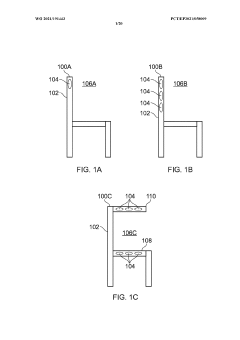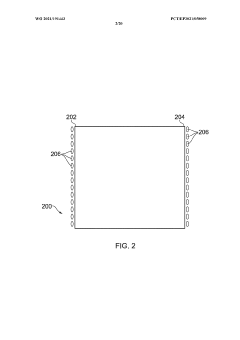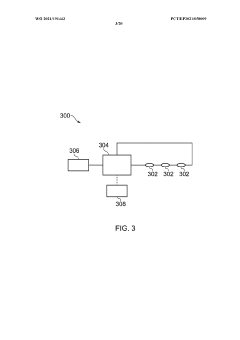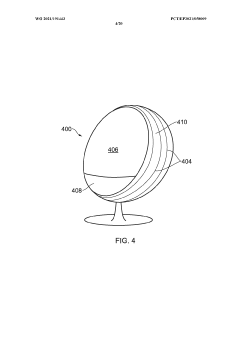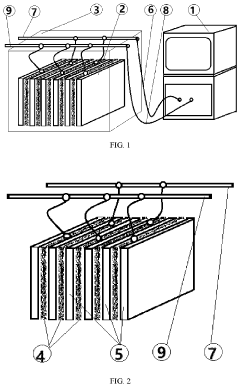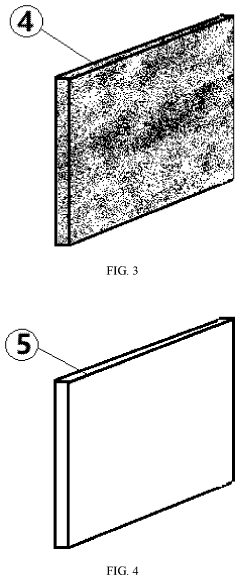How to Predict Weather Changes Using Schumann Resonance?
JUN 24, 20259 MIN READ
Generate Your Research Report Instantly with AI Agent
Patsnap Eureka helps you evaluate technical feasibility & market potential.
Schumann Resonance Background and Weather Prediction Goals
Schumann resonances, discovered by physicist Winfried Otto Schumann in 1952, are global electromagnetic resonances generated and excited by lightning discharges in the cavity formed by the Earth's surface and the ionosphere. These resonances occur at extremely low frequencies (ELF) with fundamental modes around 7.83 Hz and harmonics at approximately 14.3, 20.8, 27.3, and 33.8 Hz.
The relationship between Schumann resonances and weather patterns has been a subject of increasing interest in recent years. Researchers have observed correlations between variations in Schumann resonance parameters and meteorological phenomena, suggesting potential applications in weather prediction and climate monitoring.
The primary goal of using Schumann resonances for weather prediction is to develop a novel, global-scale method for forecasting atmospheric changes and extreme weather events. This approach aims to complement existing meteorological techniques by providing additional data on large-scale atmospheric dynamics and electromagnetic interactions.
One of the key objectives is to establish reliable correlations between Schumann resonance characteristics (such as frequency, amplitude, and phase) and specific weather patterns or atmospheric conditions. This involves analyzing long-term datasets to identify consistent relationships and developing predictive models based on these observations.
Another important goal is to enhance the understanding of the complex interactions between the Earth's electromagnetic environment and atmospheric processes. This includes investigating how changes in ionospheric conditions, which affect Schumann resonances, may be linked to weather phenomena at lower altitudes.
Researchers also aim to develop advanced sensing technologies and data processing algorithms to accurately measure and interpret Schumann resonance signals. This involves overcoming challenges such as distinguishing relevant signals from background noise and accounting for various factors that can influence resonance characteristics.
Furthermore, the integration of Schumann resonance-based predictions with existing weather forecasting systems is a crucial objective. This requires developing methods to combine Schumann resonance data with other meteorological observations and models to improve overall forecast accuracy and lead times.
Ultimately, the long-term vision is to establish a global network of Schumann resonance monitoring stations that can provide real-time data for weather prediction on a planetary scale. This ambitious goal could potentially revolutionize our ability to forecast and prepare for extreme weather events, contributing to improved disaster preparedness and climate change adaptation strategies.
The relationship between Schumann resonances and weather patterns has been a subject of increasing interest in recent years. Researchers have observed correlations between variations in Schumann resonance parameters and meteorological phenomena, suggesting potential applications in weather prediction and climate monitoring.
The primary goal of using Schumann resonances for weather prediction is to develop a novel, global-scale method for forecasting atmospheric changes and extreme weather events. This approach aims to complement existing meteorological techniques by providing additional data on large-scale atmospheric dynamics and electromagnetic interactions.
One of the key objectives is to establish reliable correlations between Schumann resonance characteristics (such as frequency, amplitude, and phase) and specific weather patterns or atmospheric conditions. This involves analyzing long-term datasets to identify consistent relationships and developing predictive models based on these observations.
Another important goal is to enhance the understanding of the complex interactions between the Earth's electromagnetic environment and atmospheric processes. This includes investigating how changes in ionospheric conditions, which affect Schumann resonances, may be linked to weather phenomena at lower altitudes.
Researchers also aim to develop advanced sensing technologies and data processing algorithms to accurately measure and interpret Schumann resonance signals. This involves overcoming challenges such as distinguishing relevant signals from background noise and accounting for various factors that can influence resonance characteristics.
Furthermore, the integration of Schumann resonance-based predictions with existing weather forecasting systems is a crucial objective. This requires developing methods to combine Schumann resonance data with other meteorological observations and models to improve overall forecast accuracy and lead times.
Ultimately, the long-term vision is to establish a global network of Schumann resonance monitoring stations that can provide real-time data for weather prediction on a planetary scale. This ambitious goal could potentially revolutionize our ability to forecast and prepare for extreme weather events, contributing to improved disaster preparedness and climate change adaptation strategies.
Market Demand for Advanced Weather Forecasting
The market demand for advanced weather forecasting has been steadily increasing in recent years, driven by various factors including climate change, economic impacts of extreme weather events, and the growing need for precise weather predictions across multiple industries. Schumann resonance-based weather forecasting represents a cutting-edge approach that has the potential to revolutionize the field of meteorology and meet the rising demand for more accurate and timely weather predictions.
One of the primary drivers of market demand is the agriculture sector, which heavily relies on accurate weather forecasts for crop planning, irrigation scheduling, and pest management. With the global population expected to reach 9.7 billion by 2050, the pressure on agricultural productivity is immense. Farmers and agribusinesses are increasingly seeking advanced weather forecasting tools to optimize their operations and mitigate weather-related risks.
The energy sector is another significant contributor to the growing demand for improved weather forecasting. Renewable energy sources such as wind and solar power are highly dependent on weather conditions. As countries worldwide transition towards cleaner energy sources, the need for precise weather predictions becomes crucial for efficient energy production and grid management. Schumann resonance-based forecasting could provide valuable insights into atmospheric conditions, enabling better planning and optimization of renewable energy systems.
The transportation industry, including aviation and maritime sectors, also stands to benefit greatly from advanced weather forecasting techniques. Accurate predictions of turbulence, storms, and other weather phenomena can enhance safety, reduce fuel consumption, and improve overall operational efficiency. The global aviation weather forecasting market alone is projected to grow significantly in the coming years, driven by the increasing demand for real-time weather information.
Insurance companies and financial institutions are increasingly recognizing the value of advanced weather forecasting in risk assessment and management. With the rising frequency and intensity of extreme weather events due to climate change, these sectors are seeking more sophisticated tools to evaluate and mitigate weather-related risks. Schumann resonance-based forecasting could provide valuable data for developing more accurate risk models and pricing strategies.
The tourism industry is another sector that could benefit from improved weather forecasting. Accurate predictions can help tourism operators and travelers plan activities, manage expectations, and make informed decisions. This is particularly important for outdoor and adventure tourism, where weather conditions play a crucial role in safety and enjoyment.
Government agencies and disaster management organizations are also driving the demand for advanced weather forecasting technologies. The ability to predict severe weather events with greater accuracy and lead time can significantly improve disaster preparedness and response efforts, potentially saving lives and reducing economic losses.
As the impacts of climate change become more pronounced, there is a growing recognition of the need for long-term climate forecasting and modeling. Schumann resonance-based techniques could potentially contribute to improved climate models, helping policymakers and businesses make more informed decisions about long-term strategies and investments.
One of the primary drivers of market demand is the agriculture sector, which heavily relies on accurate weather forecasts for crop planning, irrigation scheduling, and pest management. With the global population expected to reach 9.7 billion by 2050, the pressure on agricultural productivity is immense. Farmers and agribusinesses are increasingly seeking advanced weather forecasting tools to optimize their operations and mitigate weather-related risks.
The energy sector is another significant contributor to the growing demand for improved weather forecasting. Renewable energy sources such as wind and solar power are highly dependent on weather conditions. As countries worldwide transition towards cleaner energy sources, the need for precise weather predictions becomes crucial for efficient energy production and grid management. Schumann resonance-based forecasting could provide valuable insights into atmospheric conditions, enabling better planning and optimization of renewable energy systems.
The transportation industry, including aviation and maritime sectors, also stands to benefit greatly from advanced weather forecasting techniques. Accurate predictions of turbulence, storms, and other weather phenomena can enhance safety, reduce fuel consumption, and improve overall operational efficiency. The global aviation weather forecasting market alone is projected to grow significantly in the coming years, driven by the increasing demand for real-time weather information.
Insurance companies and financial institutions are increasingly recognizing the value of advanced weather forecasting in risk assessment and management. With the rising frequency and intensity of extreme weather events due to climate change, these sectors are seeking more sophisticated tools to evaluate and mitigate weather-related risks. Schumann resonance-based forecasting could provide valuable data for developing more accurate risk models and pricing strategies.
The tourism industry is another sector that could benefit from improved weather forecasting. Accurate predictions can help tourism operators and travelers plan activities, manage expectations, and make informed decisions. This is particularly important for outdoor and adventure tourism, where weather conditions play a crucial role in safety and enjoyment.
Government agencies and disaster management organizations are also driving the demand for advanced weather forecasting technologies. The ability to predict severe weather events with greater accuracy and lead time can significantly improve disaster preparedness and response efforts, potentially saving lives and reducing economic losses.
As the impacts of climate change become more pronounced, there is a growing recognition of the need for long-term climate forecasting and modeling. Schumann resonance-based techniques could potentially contribute to improved climate models, helping policymakers and businesses make more informed decisions about long-term strategies and investments.
Current State of Schumann Resonance in Meteorology
Schumann resonance, a set of spectral peaks in the extremely low frequency (ELF) portion of the Earth's electromagnetic field spectrum, has gained increasing attention in meteorological research. Currently, its application in weather prediction is in the exploratory phase, with several research institutions and meteorological agencies investigating its potential.
The primary focus of current research is on establishing correlations between Schumann resonance parameters and various atmospheric phenomena. Scientists have observed that changes in Schumann resonance frequencies and amplitudes often precede significant weather events, such as thunderstorms, hurricanes, and even earthquakes. This has led to the hypothesis that Schumann resonance could serve as an early warning system for extreme weather conditions.
One of the most promising areas of study is the relationship between Schumann resonance and global lightning activity. As lightning strikes are a major source of excitation for Schumann resonance, researchers are developing models to use Schumann resonance measurements as a proxy for global lightning distribution. This information is crucial for understanding atmospheric electricity and its role in weather patterns.
Several meteorological stations around the world have begun incorporating Schumann resonance monitoring into their observational networks. These stations use sophisticated ELF receivers to detect and analyze Schumann resonance signals continuously. The data collected is being integrated with traditional meteorological observations to enhance weather forecasting models.
However, the interpretation of Schumann resonance data in the context of weather prediction remains challenging. The complex interactions between the Earth's surface, ionosphere, and various atmospheric processes make it difficult to isolate the specific effects of weather phenomena on Schumann resonance. Researchers are working on developing advanced signal processing techniques and machine learning algorithms to extract meaningful weather-related information from the Schumann resonance data.
Despite these challenges, the potential of Schumann resonance in meteorology is widely recognized. It offers a unique global perspective on atmospheric dynamics that complements existing weather monitoring systems. As our understanding of the relationship between Schumann resonance and weather patterns improves, it is expected to become an increasingly valuable tool in meteorological forecasting and climate research.
The primary focus of current research is on establishing correlations between Schumann resonance parameters and various atmospheric phenomena. Scientists have observed that changes in Schumann resonance frequencies and amplitudes often precede significant weather events, such as thunderstorms, hurricanes, and even earthquakes. This has led to the hypothesis that Schumann resonance could serve as an early warning system for extreme weather conditions.
One of the most promising areas of study is the relationship between Schumann resonance and global lightning activity. As lightning strikes are a major source of excitation for Schumann resonance, researchers are developing models to use Schumann resonance measurements as a proxy for global lightning distribution. This information is crucial for understanding atmospheric electricity and its role in weather patterns.
Several meteorological stations around the world have begun incorporating Schumann resonance monitoring into their observational networks. These stations use sophisticated ELF receivers to detect and analyze Schumann resonance signals continuously. The data collected is being integrated with traditional meteorological observations to enhance weather forecasting models.
However, the interpretation of Schumann resonance data in the context of weather prediction remains challenging. The complex interactions between the Earth's surface, ionosphere, and various atmospheric processes make it difficult to isolate the specific effects of weather phenomena on Schumann resonance. Researchers are working on developing advanced signal processing techniques and machine learning algorithms to extract meaningful weather-related information from the Schumann resonance data.
Despite these challenges, the potential of Schumann resonance in meteorology is widely recognized. It offers a unique global perspective on atmospheric dynamics that complements existing weather monitoring systems. As our understanding of the relationship between Schumann resonance and weather patterns improves, it is expected to become an increasingly valuable tool in meteorological forecasting and climate research.
Existing Methods for Schumann Resonance-Based Weather Prediction
01 Schumann resonance monitoring devices
Various devices have been developed to monitor and measure Schumann resonances, which can be used to detect changes in weather patterns and atmospheric conditions. These devices typically include sensors, antennas, and signal processing units to capture and analyze the low-frequency electromagnetic waves associated with Schumann resonances.- Schumann Resonance monitoring devices: Various devices and systems have been developed to monitor and measure Schumann Resonance frequencies. These devices can be used to detect changes in the Earth's electromagnetic field, which may be associated with weather patterns and other environmental phenomena. The monitoring equipment often includes sensors, antennas, and signal processing units to capture and analyze the low-frequency electromagnetic waves.
- Weather prediction using Schumann Resonance data: Researchers have explored the potential use of Schumann Resonance data for weather prediction and forecasting. By analyzing changes in the Schumann Resonance frequencies and intensities, it may be possible to identify correlations with atmospheric conditions and upcoming weather events. This approach could complement traditional meteorological methods and potentially improve the accuracy of weather forecasts.
- Schumann Resonance and climate change studies: Scientists are investigating the relationship between Schumann Resonance and long-term climate changes. By studying historical Schumann Resonance data and comparing it with climate records, researchers aim to identify potential links between electromagnetic phenomena and global climate patterns. This research could contribute to a better understanding of climate change mechanisms and their effects on the Earth's electromagnetic environment.
- Schumann Resonance-based early warning systems: Early warning systems based on Schumann Resonance monitoring have been proposed for detecting and predicting severe weather events or natural disasters. These systems analyze variations in Schumann Resonance parameters to identify potential precursors to earthquakes, hurricanes, or other extreme weather phenomena. By providing advanced warning, these systems could help improve disaster preparedness and response efforts.
- Integration of Schumann Resonance data in weather models: Efforts are being made to integrate Schumann Resonance data into existing weather models and forecasting systems. By incorporating this additional layer of information, meteorologists aim to enhance the accuracy and reliability of weather predictions. This integration may involve developing new algorithms and data processing techniques to effectively utilize Schumann Resonance measurements in conjunction with traditional weather data sources.
02 Weather prediction using Schumann resonance data
Schumann resonance measurements can be utilized for weather prediction and forecasting. By analyzing changes in the resonance frequencies and amplitudes, researchers can potentially identify correlations with upcoming weather events or atmospheric disturbances. This approach may complement traditional meteorological methods for more accurate weather forecasting.Expand Specific Solutions03 Integration of Schumann resonance data with other weather monitoring systems
Combining Schumann resonance measurements with data from other weather monitoring systems can provide a more comprehensive understanding of atmospheric conditions and potential weather changes. This integration may involve incorporating Schumann resonance data into existing weather models or developing new algorithms that consider multiple data sources for improved accuracy.Expand Specific Solutions04 Schumann resonance-based early warning systems
Early warning systems based on Schumann resonance monitoring have been proposed for detecting and predicting severe weather events or natural disasters. These systems aim to provide timely alerts by identifying specific patterns or anomalies in Schumann resonance measurements that may indicate impending weather changes or geological events.Expand Specific Solutions05 Portable Schumann resonance detectors for personal weather monitoring
Portable devices capable of detecting Schumann resonances have been developed for personal use in weather monitoring and prediction. These compact devices allow individuals to measure local electromagnetic field variations and potentially correlate them with weather changes, providing a personalized approach to weather awareness and forecasting.Expand Specific Solutions
Key Players in Schumann Resonance Research
The field of predicting weather changes using Schumann Resonance is in its early developmental stage, with a growing market potential as climate monitoring becomes increasingly crucial. The technology's maturity is still evolving, with various research institutions and companies exploring its applications. Universities like Chengdu University of Information Technology, Nanjing University, and the University of Bern are at the forefront of academic research. Companies such as The Boeing Co. and Seiko Epson Corp. are investigating potential commercial applications. Research institutes like China Electric Power Research Institute Ltd. and Electric Power Research Institute of Yunnan Power Grid Co., Ltd. are focusing on the technology's implications for power grid management. The competitive landscape is diverse, with a mix of academic, corporate, and governmental entities contributing to the field's advancement.
Chengdu University of Information Technology
Technical Solution: Chengdu University of Information Technology has developed a novel approach to weather prediction using Schumann Resonance. Their method focuses on analyzing the frequency and amplitude variations of the first three Schumann Resonance modes. They have created a custom-designed ELF antenna system optimized for Schumann Resonance detection, coupled with a high-resolution spectral analysis software. The university's research team has established correlations between specific Schumann Resonance patterns and regional weather changes, particularly for predicting severe weather events in Southwest China. Their system incorporates real-time data processing and utilizes artificial neural networks to improve prediction accuracy over time. Additionally, they have integrated their Schumann Resonance-based predictions with traditional meteorological models to create a more robust forecasting system.
Strengths: Specialized hardware and software for Schumann Resonance detection; Focus on regional weather patterns; Integration with traditional forecasting methods. Weaknesses: Limited geographical scope of current research; Requires further validation for long-term weather predictions; Sensitivity to local electromagnetic disturbances.
Nanjing University
Technical Solution: Nanjing University has developed an innovative approach to weather prediction using Schumann Resonance observations. Their method involves a network of precisely calibrated ELF receivers strategically placed across Eastern China. The university's research team has created a unique algorithm that analyzes not only the amplitude and frequency of Schumann Resonance signals but also their phase relationships. This approach allows for more nuanced detection of atmospheric changes. They have developed a proprietary software platform that integrates Schumann Resonance data with other meteorological parameters, including upper atmospheric wind patterns and ionospheric conditions. The system employs advanced statistical methods and machine learning algorithms to identify correlations between Schumann Resonance variations and specific weather patterns, with a particular focus on predicting monsoon dynamics and severe storm systems in East Asia.
Strengths: High-precision ELF detection network; Advanced analysis of Schumann Resonance phase relationships; Integration with multiple meteorological parameters. Weaknesses: Currently limited to regional weather patterns; Requires ongoing calibration and maintenance of the ELF network; Complexity of the system may limit widespread adoption.
Core Innovations in Schumann Resonance Analysis
A magnetic field exposure system and uses thereof
PatentWO2021191443A1
Innovation
- A magnetic field exposure system generating an amplitude-modulated low frequency magnetic field with a carrier frequency of 360 to 450 Hz and a modulation frequency of 0.5 to 100 Hz, with a field strength of 0.5 to 250 mT, specifically designed to expose organic cells or tissues to improve cell survival, proliferation, reduce stress, and enhance well-being.
Carbon allotrope composite field effect artificial aurora generating device
PatentActiveUS20200406223A1
Innovation
- A carbon allotrope composite field effect artificial aurora generating device using foamed nickel or carbon fiber substrates with a carbon allotrope composite, producing high-energy charged particles through Schumann resonance and low-frequency electric fields, which are used to excite auroras and generate active oxygen for pollution reduction.
Data Integration and AI in Schumann Resonance Analysis
The integration of advanced data analysis techniques and artificial intelligence (AI) has revolutionized the field of Schumann Resonance (SR) analysis, offering unprecedented insights into weather prediction. This synergy between data integration and AI has opened new avenues for understanding the complex relationships between SR signals and atmospheric phenomena.
Data integration in SR analysis involves combining multiple data sources to create a comprehensive picture of electromagnetic activity in the Earth-ionosphere cavity. These sources include global SR monitoring networks, satellite-based observations, and traditional meteorological data. By integrating these diverse datasets, researchers can identify correlations between SR patterns and weather events with greater accuracy and reliability.
AI algorithms, particularly machine learning models, play a crucial role in processing and interpreting the vast amounts of data generated by SR monitoring systems. Deep learning techniques, such as convolutional neural networks (CNNs) and long short-term memory (LSTM) networks, have shown remarkable success in identifying subtle patterns and anomalies in SR signals that may indicate impending weather changes.
One of the key advantages of AI in SR analysis is its ability to handle non-linear relationships and complex interactions between variables. This is particularly important in weather prediction, where numerous factors contribute to atmospheric dynamics. AI models can learn from historical data to recognize patterns that precede specific weather events, enabling more accurate forecasts.
Real-time data processing and analysis are essential for timely weather predictions. AI-powered systems can continuously monitor SR data streams, quickly identifying significant changes that may indicate developing weather patterns. This rapid analysis allows for earlier detection of potential severe weather events, providing valuable lead time for warnings and preparedness measures.
The integration of AI with SR analysis also facilitates the development of more sophisticated weather models. By incorporating SR data alongside traditional meteorological inputs, these models can capture a more holistic view of atmospheric conditions, leading to improved accuracy in both short-term and long-range forecasts.
As AI technologies continue to advance, the potential for SR-based weather prediction grows. Future developments may include the use of quantum computing to process even larger datasets and more complex models, further enhancing our ability to understand and predict weather patterns through Schumann Resonance analysis.
Data integration in SR analysis involves combining multiple data sources to create a comprehensive picture of electromagnetic activity in the Earth-ionosphere cavity. These sources include global SR monitoring networks, satellite-based observations, and traditional meteorological data. By integrating these diverse datasets, researchers can identify correlations between SR patterns and weather events with greater accuracy and reliability.
AI algorithms, particularly machine learning models, play a crucial role in processing and interpreting the vast amounts of data generated by SR monitoring systems. Deep learning techniques, such as convolutional neural networks (CNNs) and long short-term memory (LSTM) networks, have shown remarkable success in identifying subtle patterns and anomalies in SR signals that may indicate impending weather changes.
One of the key advantages of AI in SR analysis is its ability to handle non-linear relationships and complex interactions between variables. This is particularly important in weather prediction, where numerous factors contribute to atmospheric dynamics. AI models can learn from historical data to recognize patterns that precede specific weather events, enabling more accurate forecasts.
Real-time data processing and analysis are essential for timely weather predictions. AI-powered systems can continuously monitor SR data streams, quickly identifying significant changes that may indicate developing weather patterns. This rapid analysis allows for earlier detection of potential severe weather events, providing valuable lead time for warnings and preparedness measures.
The integration of AI with SR analysis also facilitates the development of more sophisticated weather models. By incorporating SR data alongside traditional meteorological inputs, these models can capture a more holistic view of atmospheric conditions, leading to improved accuracy in both short-term and long-range forecasts.
As AI technologies continue to advance, the potential for SR-based weather prediction grows. Future developments may include the use of quantum computing to process even larger datasets and more complex models, further enhancing our ability to understand and predict weather patterns through Schumann Resonance analysis.
Environmental Factors Affecting Schumann Resonance Measurements
Schumann resonances, the electromagnetic waves that exist in the Earth-ionosphere cavity, are influenced by various environmental factors that can significantly impact their measurements and interpretation. These factors play a crucial role in understanding the relationship between Schumann resonances and weather prediction.
One of the primary environmental factors affecting Schumann resonance measurements is atmospheric conductivity. Changes in temperature, humidity, and air pressure can alter the conductivity of the atmosphere, which in turn affects the propagation of electromagnetic waves. For instance, increased humidity can lead to higher atmospheric conductivity, potentially altering the amplitude and frequency of Schumann resonances.
Solar activity is another critical factor that influences Schumann resonance measurements. Solar flares and coronal mass ejections can cause disturbances in the Earth's ionosphere, leading to variations in the resonance patterns. These solar-induced changes can complicate the interpretation of Schumann resonance data for weather prediction purposes.
Geomagnetic storms, often associated with solar activity, can also impact Schumann resonance measurements. These storms can cause significant fluctuations in the Earth's magnetic field, potentially masking or distorting the Schumann resonance signals. Researchers must account for these geomagnetic disturbances when analyzing resonance data for weather prediction.
Seasonal variations play a role in Schumann resonance measurements as well. The changing position of the Earth relative to the Sun throughout the year affects the ionosphere's properties, which can lead to seasonal patterns in resonance characteristics. These seasonal changes must be considered when using Schumann resonances for long-term weather forecasting.
Local weather conditions at measurement sites can also influence Schumann resonance data. Thunderstorms, precipitation, and other meteorological phenomena can introduce noise and interference into the measurements. Proper shielding and filtering techniques are essential to minimize these local environmental effects on the data quality.
Human activities and technological interference are increasingly important factors affecting Schumann resonance measurements. Electromagnetic pollution from power lines, radio transmissions, and other electronic devices can introduce noise and distortions into the resonance signals. Careful site selection and advanced signal processing techniques are necessary to mitigate these anthropogenic influences.
Understanding and accounting for these environmental factors is crucial for accurately interpreting Schumann resonance data in the context of weather prediction. Researchers must develop sophisticated algorithms and models that can differentiate between environmental influences and genuine weather-related changes in the resonance patterns. By carefully considering these factors, scientists can enhance the reliability and accuracy of weather predictions based on Schumann resonance measurements.
One of the primary environmental factors affecting Schumann resonance measurements is atmospheric conductivity. Changes in temperature, humidity, and air pressure can alter the conductivity of the atmosphere, which in turn affects the propagation of electromagnetic waves. For instance, increased humidity can lead to higher atmospheric conductivity, potentially altering the amplitude and frequency of Schumann resonances.
Solar activity is another critical factor that influences Schumann resonance measurements. Solar flares and coronal mass ejections can cause disturbances in the Earth's ionosphere, leading to variations in the resonance patterns. These solar-induced changes can complicate the interpretation of Schumann resonance data for weather prediction purposes.
Geomagnetic storms, often associated with solar activity, can also impact Schumann resonance measurements. These storms can cause significant fluctuations in the Earth's magnetic field, potentially masking or distorting the Schumann resonance signals. Researchers must account for these geomagnetic disturbances when analyzing resonance data for weather prediction.
Seasonal variations play a role in Schumann resonance measurements as well. The changing position of the Earth relative to the Sun throughout the year affects the ionosphere's properties, which can lead to seasonal patterns in resonance characteristics. These seasonal changes must be considered when using Schumann resonances for long-term weather forecasting.
Local weather conditions at measurement sites can also influence Schumann resonance data. Thunderstorms, precipitation, and other meteorological phenomena can introduce noise and interference into the measurements. Proper shielding and filtering techniques are essential to minimize these local environmental effects on the data quality.
Human activities and technological interference are increasingly important factors affecting Schumann resonance measurements. Electromagnetic pollution from power lines, radio transmissions, and other electronic devices can introduce noise and distortions into the resonance signals. Careful site selection and advanced signal processing techniques are necessary to mitigate these anthropogenic influences.
Understanding and accounting for these environmental factors is crucial for accurately interpreting Schumann resonance data in the context of weather prediction. Researchers must develop sophisticated algorithms and models that can differentiate between environmental influences and genuine weather-related changes in the resonance patterns. By carefully considering these factors, scientists can enhance the reliability and accuracy of weather predictions based on Schumann resonance measurements.
Unlock deeper insights with Patsnap Eureka Quick Research — get a full tech report to explore trends and direct your research. Try now!
Generate Your Research Report Instantly with AI Agent
Supercharge your innovation with Patsnap Eureka AI Agent Platform!
